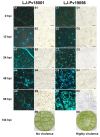Origin and pathogenicity variation of Plasmopara viticola in China
- PMID: 39881981
- PMCID: PMC11774888
- DOI: 10.3389/fmicb.2024.1433024
Origin and pathogenicity variation of Plasmopara viticola in China
Abstract
Grapevine downy mildew caused by Plasmopara viticola (Pv) is one of the most devastating diseases of grapevine in China. To understand the origin and pathogenicity of Chinese Pv, a total of 193 single-sporangiophore isolates were obtained from 14 Chinese major viticulture areas. Phylogenetic analyses suggest that Chinese Pv isolates originate from North America and belong to the P. viticola clade aestivalis. Host range experiments reveal that Chinese Pv are able to infect a wide range of Vitis species from different geographic origins, including Eurasian species Vitis vinifera, North American species V. aestivalis, V. riparia, and V. rupestris, and East Asian Vitis species V. davidii, V. amurensis, and V. hancockii. Analyses of the interactions between Pv isolates and grapevines reveal that the virulence of Pv isolates is correlated with the occurrence time and magnitude of hypersensitive response-mediating leaf necrosis in grape leaves caused by Pv. These understandings of genetic diversity and pathogenicity of Chinese Pv isolate would be useful to develop strategies for controlling grapevine downy mildew spread.
Keywords: Vitis species; downy mildew; hypersensitive response; pathogenicity test; plant-pathogen interaction.
Copyright © 2025 Wu, Chen, Huang, Li, Yang, Lv, Yin, Qu, Song, Peng, Fu and Lu.
Conflict of interest statement
The authors declare that the research was conducted in the absence of any commercial or financial relationships that could be construed as a potential conflict of interest.
Figures




Similar articles
-
Geographic distribution of cryptic species of Plasmopara viticola causing downy mildew on wild and cultivated grape in eastern North America.Phytopathology. 2014 Jul;104(7):692-701. doi: 10.1094/PHYTO-08-13-0225-R. Phytopathology. 2014. PMID: 24915427
-
Competition Between Plasmopara viticola Clade riparia and Clade aestivalis: A Race to Lead Grape Downy Mildew Epidemics.Plant Dis. 2022 Nov;106(11):2866-2875. doi: 10.1094/PDIS-11-21-2465-RE. Epub 2022 Oct 12. Plant Dis. 2022. PMID: 35536207
-
Plasmopara viticola effector PvCRN11 induces disease resistance to downy mildew in grapevine.Plant J. 2024 Feb;117(3):873-891. doi: 10.1111/tpj.16534. Epub 2023 Nov 11. Plant J. 2024. PMID: 37950600
-
Plasmopara viticola the Causal Agent of Downy Mildew of Grapevine: From Its Taxonomy to Disease Management.Front Microbiol. 2022 May 11;13:889472. doi: 10.3389/fmicb.2022.889472. eCollection 2022. Front Microbiol. 2022. PMID: 35633680 Free PMC article. Review.
-
The pathogenicity of Plasmopara viticola: a review of evolutionary dynamics, infection strategies and effector molecules.BMC Plant Biol. 2024 Apr 24;24(1):327. doi: 10.1186/s12870-024-05037-0. BMC Plant Biol. 2024. PMID: 38658826 Free PMC article. Review.
References
-
- Bellin D., Peressotti E., Merdinoglu D., Wiedemann-Merdinoglu S., Adam-Blondon A. F., Cipriani G., et al. . (2009). Resistance to Plasmopara viticola in grapevine 'Bianca' is controlled by a major dominant gene causing localised necrosis at the infection site. Brain Cogn. Educ. 120, 163–176. doi: 10.1007/s00122-009-1167-2 - DOI - PubMed
-
- Dick M. W. (2002). “Towards and understanding of the evolution of the downy mildews” in Advances in downy mildew research. eds. Spencer-Phillips P. T. N., Gisi U., Lebeda A. F. (Netherlands: Springer; ).
LinkOut - more resources
Full Text Sources

